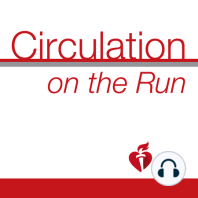16 min listen
Circulation September 3, 2019 Issue
ratings:
Length:
24 minutes
Released:
Sep 3, 2019
Format:
Podcast episode
Description
Dr Carolyn Lam: Welcome to Circulation On The Run, your weekly podcast summary and backstage pass to the journal and its editors. We're your cohosts. I'm Dr Carolyn Lam, associate editor from the National Heart Center and Duke National University of Singapore. Dr Greg Hundley: And I'm Greg Hundley, associate editor from the Pauley Heart Center at VCU Health in Richmond, Virginia. Dr Carolyn Lam: So Greg, have you ever wondered what is the clinical significance of exercise induced cardiac troponin eye release with regards to mortality and cardiovascular events? Dr Greg Hundley: Well, being a runner, and you are too, I actually have wondered about that. Dr Carolyn Lam: Well guess what? I'm not going to tell you the answer because you're going to have to wait for our feature discussion coming right up after we chat about a few wonderful papers in this week's issue. And I want to start. So the first paper I chose really sought to discover new and effective drug treatments for ischemic stroke. And it did this by integrating genetic and proteomic data through Mendelian randomization analysis. Dr Greg Hundley: So Carolyn, what is Mendelian randomization analysis? Dr Carolyn Lam: Well, I would have loved to quiz you on that, but since you already asked me, I'll tell you. So Mendelian randomization is a statistical genetics framework that's used to assess causality between an exposure and an outcome. So similar to how randomized controlled trials randomly allocate an intervention to test its causal effect on an outcome. Well, Mendelian randomization represents a sort of natural randomized control trial that leverages the random allocation of exposure influencing genetic alleles. Now previously, this technique of Mendelian randomization was applied in a hypothesis driven manner to assess causality of selected biomarkers on stroke risk, for example. However, there has been no systematic scan of the human proteome for novel causal mediators of stroke. And beyond drug target prioritization, Mendelian randomization can actually also be applied to predict target mediated side effects to reveal unanticipated adverse effects and opportunities for drug re-purposing. Hence, in the current paper, the authors led by Dr Paré from Hamilton Health Sciences, McMasters University and colleagues, use Mendelian randomization to firstly systematically screen 653 circulating proteins to identify novel mediators of ischemic stroke subtypes. Secondly, examine the relationship between identified biomarkers and the risk of intracranial bleeding. And thirdly, predict target mediated side effects through phenome wide analysis. They found that among these 653 proteins, seven were causal mediators of ischemic stroke, including two established targets, apolipoprotein allele and coagulation factor 11. As well as two novel mediators of cardioembolic stroke, which were scavenger receptor class A5, or SCARA5, and tumor necrosis factor weak inducer of apoptosis. They further showed that targeting SCARA5 was predicted to also protect against subarachnoid hemorrhage with no evidence of it for side effects. Some biomarkers mediate at risk of multiple non-stroke disorders. So in summary, integrating genomic, proteomic and phenomic data through Mendelian randomization facilitated discovery of drug targets and their side effects. Their findings provide confirmatory evidence for pursuing clinical trials of coagulation factor 11 and apolipoprotein allele. Furthermore, SCARA5 represents a new therapeutic target. Neat, huh? Dr Greg Hundley: You bet. Well, my basic paper, Dr Carolyn Lam, focuses on the border zones of infarcts. And it comes to us from Vincent Christoffels from the Academic Medical Center in Amsterdam. So surviving
Released:
Sep 3, 2019
Format:
Podcast episode
Titles in the series (100)
Circulation June 6, 2017 Issue: Circulation Weekly: Your Weekly Summary & Backstage Pass To The Journal by Circulation on the Run
